Research shows higher digital patient engagement rates can have positive impact on payments and free time for practices
Patient engagement is vital to a practice’s success. Providers throughout the healthcare ecosystem know that oftentimes the key to the most sustainable wellness plan lies in buy-in from the patient. Patients that feel engaged in their care plan are more likely to adhere to it and are more likely to return to their provider for future care1—which is especially important for practices using value-based care (VBC) payment models. What’s more, patient engagement across digital tools and platforms like apps, patient portals, text, and email is shown to improve adherence to individual wellness plans and strengthen the patient-provider relationship2, leading to healthier patients down the line.
As AI-powered patient engagement tools become more widely implemented, patients will expect to have more customized experiences when interacting with their doctor’s office. Forward-thinking practices should aim to improve the ways they digitally engage with patients, starting now. But how do you measure success? Let’s dig a bit deeper.
How do digital tools impact provider and patient experience?
Knowing how integral patient digital engagement can be to overall practice performance, we set out to discover how levels of patient digital engagement can impact practice success. To achieve this, we tapped experts on the athenahealth Research team to determine answers to critical questions like, what impact does patient digital engagement have on a practice? And how do patients themselves feel about engaging with providers online?
Using the Patient Digital Engagement Index, a distinct metric based on key indicators of digital patient action across categories, the athenahealth Research team gathered critical data from a sample including over 6,300 practices on the athenaOne® network and over 50 million patients. By tracking the PDEI scores of these practices between 2021-2024, we could learn not only if patient digital engagement has increased, but also how certain practices might be engaging better with patients, and how this could impact providers.
But before we dive into the methodology and key results of our research, we’ll first define what we mean by the Patient Digital Engagement Index (PDEI), and the importance of this unique metric in helping practices track patient engagement across digital platforms and tools.
What is the Patient Digital Engagement Index?
Patient digital engagement today can be assessed in a number of ways, such as telehealth appointments, patient self-scheduling, messages through patient portals, and more. Using athenaOne, practices can measure and track patient engagement by using the Patient Digital Engagement Index (PDEI), a method of measurement that is completely unique to athenahealth.
PDEI is a metric within athenahealth’s Insights Dashboard that helps practices to track patient use of digital tools that interact with our EHR, including our Marketplace partners. We track three core digital activity categories that comprise the overall PDEI score: access to care, financial activity, and healthcare information. That data is then aggregated into an individual Patient Digital Engagement Index (PDEI) score for each practice, which customers can view and measure through the Insights Dashboard.

So, how do we define these key dimensions that factor into an overall PDEI score? We do this using three core factors:
- Access to care = How many patient appointments are booked, confirmed, rescheduled, or cancelled using online tools
- Financial activity = How many bills are paid online and how many statements are delivered electronically
- Healthcare information = How many times patients digitally check in before the appointment and how often they view their test results online
Tracking and measuring a practice’s PDEI score is critical for those who are looking to better engage patients, drive patient satisfaction and retention, and ensure their practice remains financially stable. When we understand how patients engage across platforms, we can not only strengthen and improve our digital tools but also help drive adherence to wellness plans and close care gaps. With this in mind, we endeavored to get a better picture of the state of patient digital engagement today using PDEI scores across the athenahealth network, and hoped to discover how patients feel about digital self-serve, and how practices might see the benefits of increased engagement.
Let’s take a closer look at our methodology for this research.
Study methodology
In order to capture the most accurate data, the Research team used both quantitative and qualitative data from three different samples below.
Quantitative sample
The parameters for the PDEI quantitative sample included: clinical organizations that opted into research, were enrolled in athenaOne, active between January 2021 to June 2024, and had valid PDEI measurements every month.
To calculate how patient digital engagement could affect certain factors, the Research team used a predictive model, called a multivariate regression, that adjusts for clinical characteristics (size, tenure, specialty, etc.). This allowed the team to understand the potential association of PDEI with several key metrics, beyond the impacts caused by other clinical characteristics. Digital engagement for this quantitative sample was measured using the annual PDEI for each practice, with aggregate measures reporting the median PDEI score across organizations.
Patient survey
The Research team supplemented this data with a patient survey of 1,000 patients across the U.S, not restricted to athenahealth. Participant demographics were split evenly by gender, and had a varying distribution across race, age, and ethnic background. Almost all (90%) had visited a doctor within the past year.
The 10-question survey asked patients about how they interact with digital tools across the healthcare ecosystem, including: which digital tools they currently use, do these tools help simplify their interactions with the healthcare system, and how they currently interact with their online medical record.
Qualitative sample
Finally, the team has conducted semi-structured customer interviews to examine practice perspectives on patient digital engagement. We’ve highlighted interviews from two customers, with more data to come next year: a solo Obstetrics and Gynecology practice in San Francisco, California focusing on comprehensive women’s care, and an internal and family medicine practice in Augusta, Georgia.
Now that we’ve reviewed the study methodology, let’s go ahead and dive deeper into the key results from these three samples.
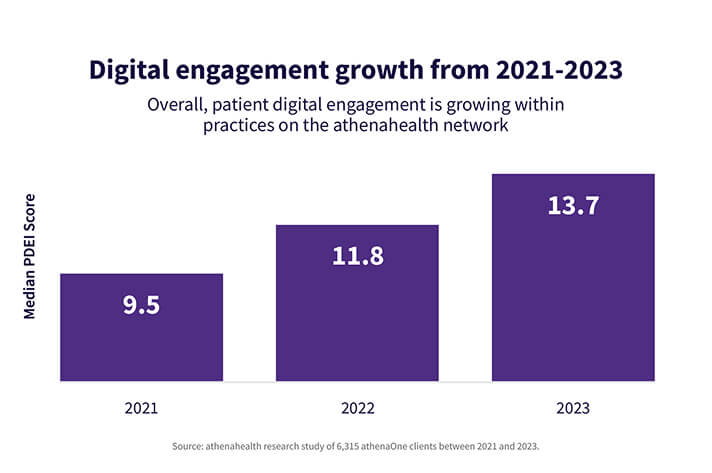
Key findings
The key results of this study can be broken down into three parts according to the quantitative data from PDEI scores, the qualitative customer interviews, and the patient survey.
Quantitative results
Topline takeaways
- While patient digital engagement has steadily grown from 2021-2023, the median score for 2023 is still only ~14 out of 100, highlighting the opportunity for improvement across the activities athenahealth tracks (messaging, scheduling, and payments). The practice scores for this study ranged widely, with some practices receiving scoring as high as 60.
- Overall, we found that the larger the organization, the higher the median PDEI score.
- The most digitally engaged patients are White or Asian millennial women who live in more urban areas (as compared to other races, genders, age groups, and geographic locations).
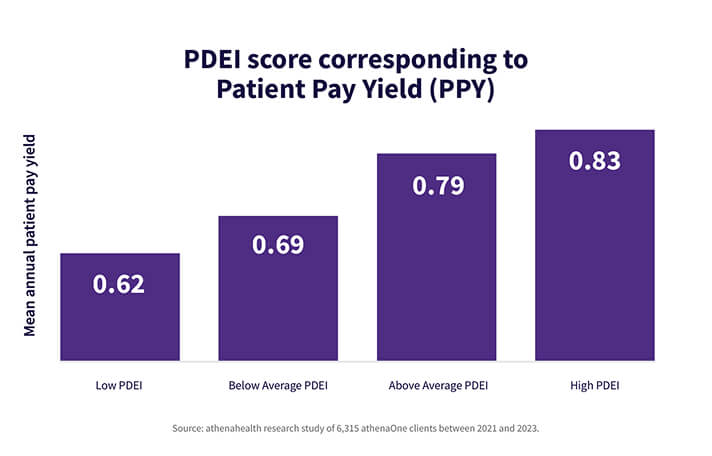
Financial benefits of increased PDEI
- Patient use of digital tools to pay bills, view statements and bills, and perform other financial tasks have had the highest rate of overall growth among patient digital engagement activities for practices between 2021-2024.
- Higher PDEI scores correlate with higher patient pay yields for practices, meaning these practices collect a higher portion of the patient responsibility from their patients and therefore write off less. A one-point increase in PDEI was found to be associated with a one-point increase in the proportion of total patient charges paid within one year.
- Overall, these findings suggest that investing in patient digital engagement can have a positive impact on practice performance and clinician satisfaction.
Comparison among specialties
- Women’s health and behavioral health are shown to have the highest digital engagement scores among specialties, with a median PDEI score of ~20-24. This tracks with other key findings demonstrating that these specialties tend to have patients who are more digitally engaged.
- FQHC digital engagement has improved more quickly than other organization types. FQHCs started from a lower baseline score but have shown rapid improvement over the course of the study. This could be driven by better, easier-to-use tools, or FQHC use of federal programs that provide free cell phones or other digital engagement support.
Impact of PDEI score on after-hours time
- Initial findings revealed that clinicians working for practices with higher PDEI scores spend, on average, a lower proportion of their documentation time after hours.
- This finding runs counter to a common perception that higher patient digital engagement – and rising patient expectations more generally – could lead to more after-hours work for providers.
- The finding warrants further investigation to determine what mechanisms could be contributing to the correlation between higher PDEI and decreases in “pajama time” for the physicians in these practices. Over the next few months, the athenahealth Product and Research teams plan to investigate potential mechanisms, such as the impact of appointment reminders and self-check-in and also explore potential cross correlations with other variables.
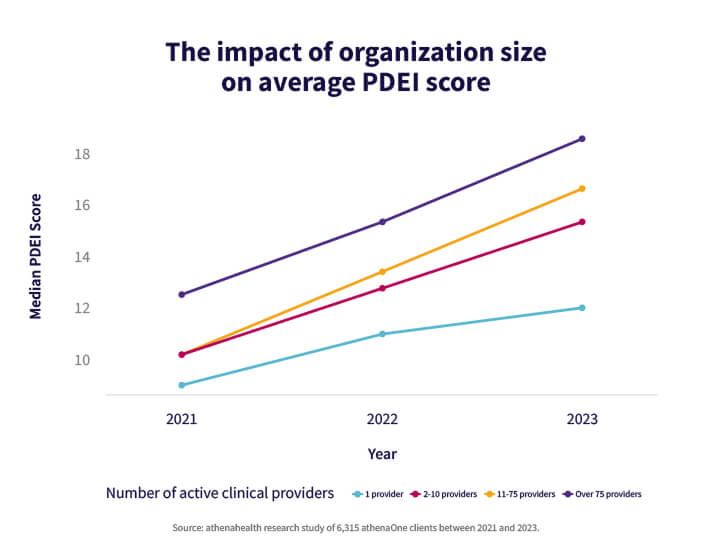
Qualitative results
Our qualitative study includes interviews with practices about how they view patient digital engagement at their practice, and what value it brings to them as providers. See quotes from those interviews below:
“When patients feel connected and involved in their healthcare, their overall experience improves significantly. Not only does it help patients feel informed and empowered, but it also saves our practice an incredible amount of time that we can then dedicate to patient care. Ultimately, investing in patient experience translates into better health outcomes and a more efficient practice.”
- Dr. Katherine Gregory, San Francisco Gynecology
“The patient portal is one that we really advocate for because we feel that it is an incredible value for our patients to have access to information, their records, their lab results.”
- Dr. Christopher Apostol, Evans Medical Group*
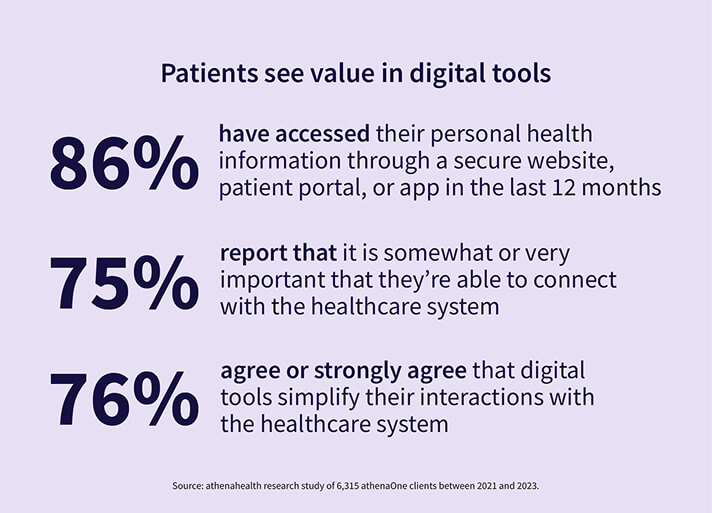
Patient survey results
- The majority of patients, over 75%, responded that it was somewhat or very important for them to use digital tools to connect with the healthcare system.
- Over 75% of patients agreed that digital tools simplify their interactions with the healthcare system.
- 86% of patients have used a patient portal, patient app, or secure site to access personal health information in the past year.
- Over 60% of patients are currently using a patient portal, making it the top digital tool, while emails, texts, and telehealth are slightly lower in level of use but still show high engagement (30-50%). The data suggests that patients currently use a variety of digital tools to engage with the healthcare ecosystem and offering a variety of tools to engage with helps meet patients where they are.
- The most common uses of digital tools include scheduling appointments, requesting medication refills, and filling out healthcare paperwork (such as intake forms).
- Patients are most interested in using digital tools to receive test results (73%), get appointment reminders (72%), and schedule their next appointment (67%).
With these results from the patient survey, we can see there is a strong appetite for using a variety of digital tools. Many patients are interested in expanding their usage of portals, apps, and websites to help them access health information and care more conveniently in future.
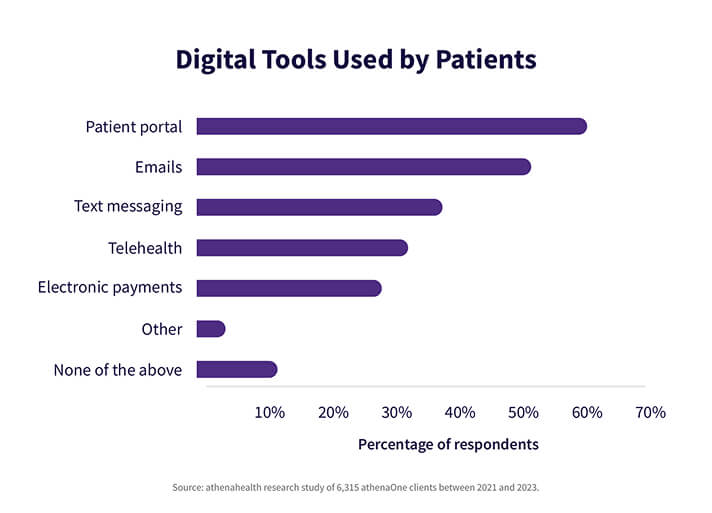
Using the learnings from this research, your practice can set yourself up for future success. Engaged patients are shown to have better wellness outcomes, so focusing on driving engagement can help your practice grow and achieve longevity in the years to come. Investing in digital engagement tools can help your practice enhance the patient experience, improve satisfaction, increase patient retention, and improve practice outcomes with value-based care. By leveraging the findings and data showcased above, providers can create a seamless, patient-centered experience that drives loyalty, better health outcomes, and more sustainable US healthcare costs.
With the emergence of AI-enabled patient engagement solutions, the time is ripe for practices to create more personal, informed, timely, and supportive experiences for patients – whether it’s by messaging a patient when an appointment slot opens or efficiently managing inbound patient inquiries to respond more quickly.
Explore our Resource Center to learn how your practice can leverage our PDEI research to drive better digital patient engagement and patient satisfaction.
Ready to learn more? Download our patient engagement whitepaper now.
More athenaInstitute resources
Continue exploring
1. Accenture. Healthcare experience: The difference between loyalty and leaving. Accenture. 2022. https://www.accenture.com/content/dam/accenture/final/accenture-com/document/Accenture-Humanizing-Healthcare-Experience-Payer-Provider-Health-POV.pdf
2. Accenture. 2022
*Dr. Christopher Apostol participates in athenahealth’s Client Advocacy Program. To learn more about the program, please visit athenahealth.com/client-advocate-hub
Note: some content was updated in October 2025 for accuracy and relevance.












